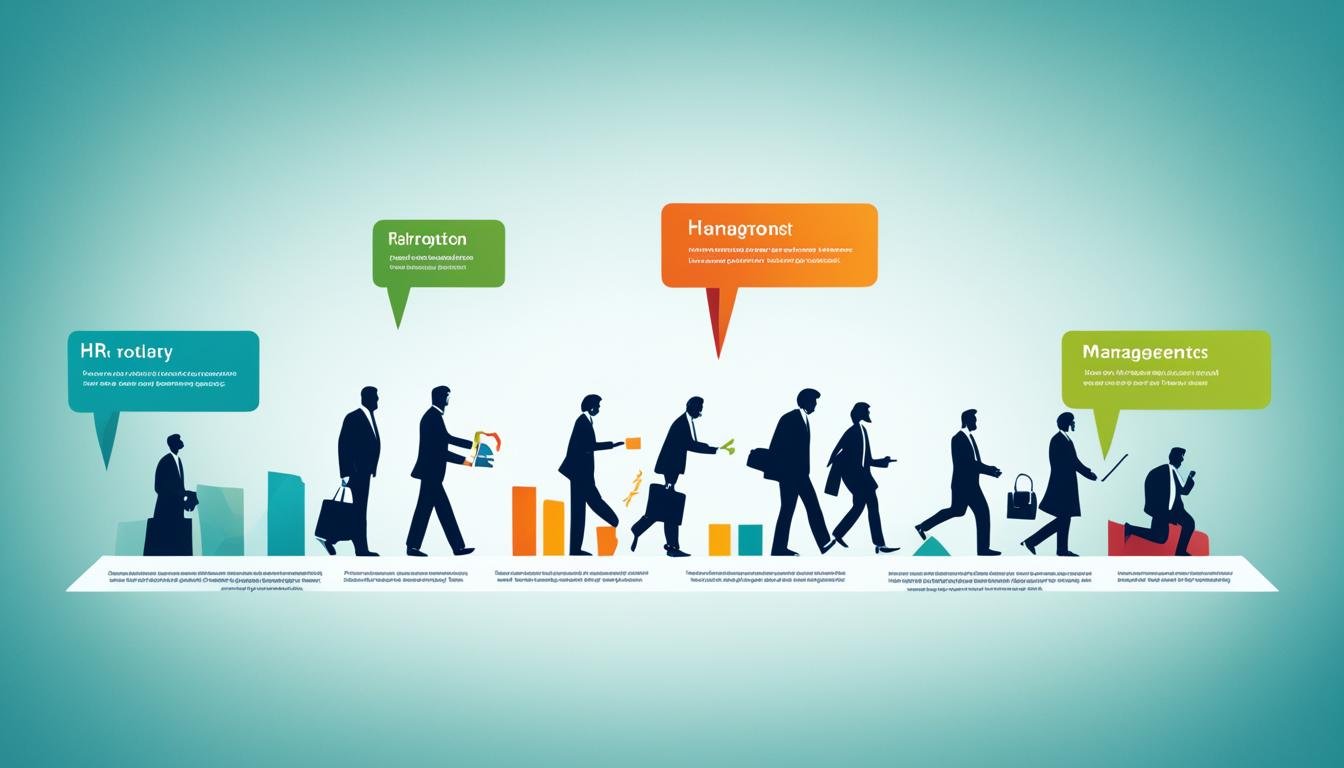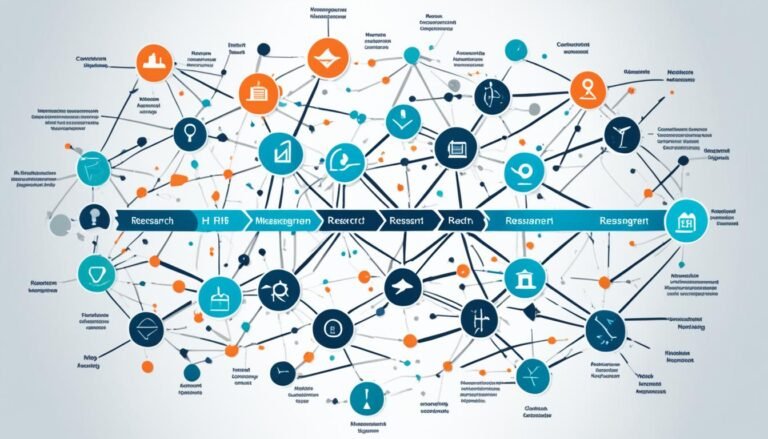A Guide to Human Resource Management Trends
In today’s rapidly evolving HR landscape, staying up-to-date with the latest human resource management trends is essential for organizations to thrive in the ever-changing world of work. As businesses face new challenges and opportunities, HR professionals play a crucial role in shaping the future of work by embracing innovative strategies and practices.
From workforce management to talent acquisition, employee engagement to workplace technology, HR trends influence every aspect of the employee experience. By staying informed and proactive, HR professionals can effectively navigate the dynamic HR landscape and drive positive change in their organizations.
Key Takeaways:
- Stay updated on the latest human resource management trends to remain competitive in the evolving world of work.
- Embrace innovative strategies and practices to address challenges and leverage opportunities.
- Focus on workforce management, talent acquisition, employee engagement, workplace technology, diversity and inclusion, performance management, and employee well-being trends.
- Strive for continuous improvement by leveraging data and digital tools for decision-making.
- Invest in professional development to enhance HR skills and stay ahead of industry trends.
Preparing for the Return to Office (RTO)
As organizations prepare for employees to return to the office, ensuring a safe and healthy environment is crucial. This includes implementing safety protocols recommended by health authorities and addressing social distancing measures. Effective communication and support for employee well-being during this transition are essential for a successful return.
In order to facilitate a smooth return to the office, organizations should prioritize workplace safety. This involves implementing measures such as:
- Regular sanitization and cleaning of office premises
- Providing hand sanitizers and sanitization stations throughout the office
- Enforcing social distancing guidelines and rearranging workspaces accordingly
- Installing plexiglass dividers in shared areas
Organizations should also establish clear channels of communication to keep employees informed about the return to office plans and safety protocols. This can be achieved through:
- Regular email updates
- Virtual town hall meetings
- Internal messaging platforms
Furthermore, supporting employee well-being during this transition is crucial. Organizations can take the following measures:
- Providing mental health resources and counseling services
- Offering flexible work arrangements to accommodate individual needs
- Encouraging open dialogue about concerns and challenges employees may face
By prioritizing workplace safety and employee well-being, organizations can create a positive and smooth return to the office experience for their employees.
| Safety Measures | Benefits |
|---|---|
| Regular sanitization and cleaning of office premises | Reduces the risk of COVID-19 transmission and maintains a clean work environment |
| Providing hand sanitizers and sanitization stations throughout the office | Promotes hand hygiene and reduces the spread of germs |
| Enforcing social distancing guidelines and rearranging workspaces accordingly | Minimizes close contact between employees and reduces the risk of infection |
| Installing plexiglass dividers in shared areas | Provides a physical barrier to prevent the spread of respiratory droplets |
Promoting Work-Life-Fitness Balance
Achieving a healthy work-life balance is essential for the well-being and productivity of employees. Organizations can take proactive steps to promote work-life-fitness balance, enabling their workforce to thrive holistically. By offering flexible work arrangements and emphasizing the importance of physical fitness and mental health, companies can create an environment that supports the overall well-being of their employees.
Flexible Work Arrangements
Flexible work arrangements are a cornerstone of promoting work-life-fitness balance. By providing options such as remote work, flexible hours, and compressed workweeks, organizations enable employees to better manage their personal and professional responsibilities. This flexibility allows individuals to allocate time for personal activities, family commitments, and self-care, resulting in reduced stress levels and increased job satisfaction.
Physical Fitness and Mental Health
Recognizing the importance of physical fitness and mental well-being, organizations can incorporate wellness initiatives into their workplace culture. The provision of wellness programs, fitness facilities, or partnerships with local gyms encourages employees to prioritize their physical health. Additionally, promoting mental health through resources like Employee Assistance Programs (EAPs), counseling services, or mindfulness workshops can contribute to a positive work environment.
“Finding time for physical fitness and prioritizing mental well-being not only enhances employee health but also improves focus, productivity, and overall happiness. It’s a win-win situation for both employees and organizations.”
Building a Culture of Work-Life Balance
Promoting work-life balance goes beyond policies and programs. It requires building a culture that recognizes and values the well-being of employees. Organizations can foster this culture by encouraging managers to role model work-life balance, supporting open communication about workload and deadlines, and recognizing and rewarding employees who prioritize work-life-fitness balance.
By integrating work-life-fitness balance into company values and practices, organizations create an environment where employees feel supported and empowered to achieve a harmonious integration of their personal and professional lives.
The Benefits of Work-Life-Fitness Balance
Promoting work-life-fitness balance yields numerous benefits for both employees and organizations. Employees experience reduced stress levels, improved job satisfaction, and enhanced overall well-being. This, in turn, leads to increased engagement, higher productivity, and lower absenteeism rates within the organization.
Moreover, organizations that prioritize work-life-fitness balance cultivate a positive employer brand, attracting top talent and retaining exceptional employees. By supporting the well-being of their workforce, companies create a thriving work environment conducive to long-term success.
Integrating AI into Workforce Management
Artificial Intelligence (AI) is revolutionizing the field of human resources, providing organizations with powerful tools to enhance workforce management. By leveraging AI technologies, companies can streamline operations, optimize decision-making, and drive employee engagement and collaboration.
AI-powered tools enable data analysis at unprecedented scales, allowing HR professionals to gain valuable insights into employee performance and organizational trends. These insights can be used to make data-driven decisions and develop targeted strategies for talent acquisition, retention, and development.
For example, AI can analyze vast amounts of employee data, such as performance metrics, feedback, and training records, to identify patterns and trends. This analysis can help HR professionals understand the factors that contribute to employee engagement and job satisfaction, enabling the implementation of targeted initiatives to foster a positive work environment.
Enhancing Employee Engagement and Collaboration
In addition to data analysis, AI-powered chatbots and virtual assistants can enhance communication and collaboration within organizations. These virtual assistants can handle routine inquiries, provide immediate feedback, and facilitate seamless information sharing, improving employee productivity and satisfaction.
Furthermore, AI can support collaboration by recommending employees with complementary skills for project teams based on their past performance and expertise. This not only promotes diversity and collaboration but also ensures that each project is staffed with the most suitable individuals.
AI-powered tools enable HR professionals to analyze data, generate insights, and drive employee engagement and collaboration. By embracing AI in workforce management, organizations can optimize decision-making and create a more efficient and inclusive work environment.
By incorporating AI into workforce management, organizations can reap numerous benefits, including increased efficiency, improved employee engagement, and enhanced collaboration. However, it is important to remember that AI should augment and support human decision-making, rather than replace it entirely. HR professionals play a critical role in interpreting AI-generated insights and maintaining ethical considerations in talent management processes.
| Benefits of AI in Workforce Management | Examples |
|---|---|
| Improved decision-making | AI-powered analytics tools provide valuable insights for talent management strategies. |
| Enhanced employee engagement | AI-powered chatbots and virtual assistants improve communication and provide immediate feedback. |
| Streamlined operations | Automated processes, such as candidate screening and onboarding, save time and resources. |
| Promotion of diversity and collaboration | AI can recommend employees with complementary skills for project teams, fostering collaboration and diversity. |
Advancing Diversity, Equity, and Inclusion (DEI)
Diversity, equity, and inclusion (DEI) are essential values for organizations to foster a thriving and inclusive workplace. By implementing inclusive hiring practices and creating an inclusive work environment, organizations can achieve DEI goals and provide equal opportunities for all employees.
Embracing Inclusive Hiring Practices
Actively seeking out diverse candidates is a crucial step towards building a diverse workforce. By broadening recruitment channels and partnering with diverse organizations, companies can attract individuals from different backgrounds and perspectives.
Training employees on diversity awareness is equally important in cultivating an inclusive work environment. Providing comprehensive diversity training programs helps foster a culture of respect, empathy, and appreciation for differences among employees.
“Diversity is being invited to the party. Inclusion is being asked to dance.” – Verna Myers
Addressing Systemic Barriers
Organizations must address systemic barriers that hinder equal opportunities within the workplace. This includes identifying and dismantling discriminatory policies, practices, and biases that perpetuate inequality.
Implementing fair and transparent performance evaluation processes is crucial in promoting equity. Performance assessments should be based on objective criteria and free from any biases related to gender, race, or other protected characteristics.
Promoting DEI through Community Outreach
Effective DEI initiatives involve engaging with the broader community and forming partnerships with diverse organizations. By collaborating with community groups and non-profit organizations, companies can contribute to social change and promote inclusivity beyond their own organizational boundaries.
Building relationships with diverse suppliers, vendors, and contractors reinforces the commitment to DEI and expands the impact beyond the internal workforce.
HR Driving Climate Change Adaptation
As organizations face the increasingly urgent challenges posed by climate change, HR professionals have a critical role to play in driving climate change adaptation from within. By integrating climate considerations into talent management strategies and actively identifying the skills needed to address climate-related challenges, HR can help build a workforce that is equipped to navigate the impacts of climate change.
One key aspect of HR’s role in climate change adaptation is workforce planning. Proactive workforce planning allows organizations to identify and address potential gaps in skills and capabilities needed to respond to climate-related challenges. By analyzing future workforce requirements and assessing the current workforce, HR can proactively source, develop, and retain individuals with the necessary expertise.
Integrating Climate Considerations into Talent Management Strategies
Effective talent management strategies should consider the climate-related challenges that organizations will face in the future. HR can play a crucial role in ensuring that talent management efforts align with the organization’s climate change adaptation goals.
HR can collaborate with other departments to identify key areas where climate change adaptation requires specific skills, such as renewable energy, sustainable supply chain management, or green technology. By incorporating these areas into the organization’s talent management plans, HR can attract and retain employees who can contribute to climate resilience.
Identifying and Developing Climate-Related Skills
An essential aspect of HR’s role in climate change adaptation is identifying the skills and competencies needed to address specific climate-related challenges. By conducting a skills gap analysis, HR can identify areas where the workforce lacks the necessary expertise.
Once skill gaps are identified, HR can invest in training and development programs to upskill employees and fill these gaps. This may involve offering courses or certifications on climate change awareness, sustainable practices, or other relevant topics. By equipping employees with the knowledge and skills needed to navigate climate-related challenges, organizations can enhance their climate resilience.
Proactive Workforce Planning and Accessing New Talent Pools
Proactive workforce planning is crucial for organizations to successfully adapt to the impacts of climate change. HR can use data analytics and forecasting techniques to project future workforce needs and identify potential skill gaps.
Additionally, HR can explore new talent pools and cultivate partnerships with organizations and educational institutions focused on climate change and sustainability. This can help broaden the organization’s talent pool and bring in individuals with specialized knowledge and skills.
By driving climate change adaptation within organizations, HR professionals can contribute to building a workforce that is prepared to navigate the challenges and seize the opportunities presented by climate change. By integrating climate considerations into talent management strategies, identifying and developing climate-related skills, and engaging in proactive workforce planning, HR can help organizations build resilience and sustainability.
HR Realigning Priorities
HR is currently undergoing a significant transformation to adapt to the changing needs of the workforce. As organizations navigate through evolving landscapes, HR professionals need to realign their priorities to drive sustainable, inclusive, and business-focused practices.
This transformation involves leveraging technology to boost productivity, adapting to global environmental shifts, and addressing legislative changes and societal movements. By integrating technology into HR processes, organizations can streamline operations, automate manual tasks, and enhance data-driven decision-making.
Additionally, HR teams must proactively address the changing workforce needs influenced by factors such as remote work, flexible schedules, and work-life balance. They need to develop innovative strategies that empower employees to thrive in these evolving work environments.
To effectively realign priorities, HR professionals should collaborate closely with other departments to ensure a cohesive approach that aligns with organizational goals. By staying attuned to market trends and the unique needs of their workforce, HR can better anticipate and address talent challenges in a proactive manner.
As HR drives initiatives for change, it is essential to emphasize sustainability and inclusivity in all practices. This involves promoting diversity, equity, and inclusion, creating safe and equitable work environments, and strengthening employee well-being programs.
The complex nature of HR transformation necessitates continuous learning and adaptability. HR professionals must stay updated on the latest trends, technologies, and best practices to effectively navigate the evolving landscape of workforce management.
Productivity as a Priority
As the workforce landscape continues to evolve, it is crucial for HR to prioritize workforce productivity. Since the 2008 financial crisis, white-collar work productivity has stagnated, necessitating a renewed focus on efficiency and performance improvement strategies. By identifying and removing bottlenecks, formulating targeted strategies, and rewarding behaviors that drive productivity, HR can create a culture of excellence within the organization.
Data analysis is a powerful tool that HR can utilize to optimize workforce productivity. By leveraging data insights, HR professionals can identify patterns, trends, and areas of improvement. These data-driven decisions can lead to more effective goal-setting and streamline processes, unlocking the full potential of the workforce.
“Data analysis is a powerful tool that HR can utilize to optimize workforce productivity.”
In addition to data analysis, goal-setting plays a pivotal role in enhancing productivity. Clear and well-defined goals provide employees with a sense of purpose and direction. HR teams should collaborate with managers and employees to establish SMART (Specific, Measurable, Achievable, Relevant, Time-bound) goals that align with the organization’s objectives. Regular progress tracking and feedback sessions help employees stay on track and make necessary adjustments to ensure goal attainment.
Advancements in technology, including AI, offer opportunities to further optimize workforce productivity. AI-powered tools can automate manual tasks, enhance communication and collaboration, and provide personalized recommendations for skill development. By embracing technology and integrating AI into workforce management practices, HR can unlock new levels of efficiency and productivity.
| Strategies for Enhancing Productivity | Benefits |
|---|---|
| Implementing clear performance metrics and targets | Ensures clarity and focus, increases motivation |
| Investing in employee training and development | Enhances skills and knowledge, improves performance |
| Promoting a positive work environment | Boosts employee morale and engagement |
| Fostering collaboration and teamwork | Encourages knowledge-sharing and innovative problem-solving |
| Recognizing and rewarding high performance | Motivates employees and reinforces desired behaviors |
Tapping into the Hidden Workforce
In today’s competitive job market, organizations are constantly seeking innovative ways to address labor shortages and enhance diversity. One often overlooked solution is tapping into the hidden workforce, which includes individuals with unique backgrounds and experiences. By embracing inclusive hiring practices and recognizing transferable skills, HR departments have the opportunity to unleash the untapped potential of retirees, caregivers, neurodiverse individuals, and ex-inmates.
Inclusive hiring practices play a crucial role in attracting and retaining diverse talent. This includes removing barriers to work by implementing fair hiring policies and creating inclusive job advertisements that resonate with a broad range of candidates. By emphasizing diversity in their hiring strategies, organizations can build a workforce that reflects the communities in which they operate, fostering an inclusive and supportive work environment.
Diversity
- Promote the benefits of diversity to create an inclusive workplace culture.
- Seek out partnerships with diverse organizations and communities for recruitment.
Taking advantage of technology can facilitate the targeting and integration of the hidden workforce. Leveraging talent acquisition platforms and AI-powered tools can help HR professionals identify and connect with individuals who possess the skills and experiences needed to drive organizational success. Technology can also simplify and streamline the onboarding process by automating administrative tasks and providing personalized experiences for new hires.
By tapping into the hidden workforce, organizations can not only address labor shortages but also foster a culture of inclusivity and diversity. Embracing inclusive hiring practices, recognizing transferable skills, and utilizing technology to facilitate talent acquisition are key steps in unlocking the potential of the hidden workforce.
Talent Acquisition
“The hidden workforce represents a valuable pool of talent that can contribute to organizational success. By tapping into this diverse and often untapped talent pool, organizations can enhance innovation, creativity, and problem-solving capabilities.”
– Jane Mitchell, HR Director at TalentX
Reimagining Diversity, Equity, and Inclusion (DEI)
In order to maximize the impact of Diversity, Equity, and Inclusion (DEI) initiatives, it is crucial to reimagine the approaches and strategies implemented within organizations. It is important to ensure that these initiatives are effective and do not negatively impact employee attitudes. By adopting inclusive hiring practices, fostering an inclusive work environment, and promoting equity, organizations can create a more diverse and inclusive workplace that values and celebrates diverse talent.
Implementing Inclusive Hiring Practices
An inclusive workplace starts with diverse talent acquisition. By implementing inclusive hiring practices, organizations can broaden their candidate pool and attract a diverse range of applicants. This includes actively seeking out candidates from underrepresented backgrounds and leveraging diverse recruitment channels. It also involves ensuring that job descriptions and requirements do not unintentionally create barriers for certain groups. Taking steps to minimize bias in the hiring process, such as blind resume screening and structured interviews, can also promote equitable practices.
Fostering an Inclusive Work Environment
An inclusive work environment is critical for creating a sense of belonging and promoting employee engagement. This includes providing diversity and inclusion training to raise awareness and foster a culture of respect and acceptance. Organizations can also establish employee resource groups or affinity networks to support and empower underrepresented employees. Encouraging open and constructive communication across all levels of the organization can help create a safe space for diverse perspectives and experiences to be shared.
Promoting Equity
Promoting equity involves addressing systemic barriers and ensuring that all employees have equal opportunities for growth and advancement. Organizations can implement equitable practices such as pay transparency, fair performance evaluation processes, and access to professional development opportunities for all employees. It is important to create a workplace culture that values and rewards meritocracy while also providing support and accommodations to individuals facing unique challenges.
Engaging in community outreach and partnering with diverse organizations can also drive meaningful change and create a more inclusive workforce. By actively collaborating with external stakeholders, organizations can expand their networks and tap into diverse talent pools. This can foster a sense of belonging and create opportunities for individuals from underrepresented communities to thrive within the organization.
Reimagining DEI requires a comprehensive and multifaceted approach that encompasses inclusive hiring practices, fostering an inclusive work environment, promoting equity, and engaging with diverse stakeholders. By embracing these actions, organizations can create a more inclusive and equitable workplace where diverse talent is valued and empowered.
Human Skills in the Future of Work
In a future where technology is transforming jobs, the importance of human skills cannot be overstated. As automation and artificial intelligence (AI) continue to reshape the workforce, soft skills such as communication, leadership, collaboration, attention to detail, and cultural intelligence are becoming increasingly valuable.
Effective communication skills will remain a key asset, as they enable individuals to convey ideas, build relationships, and resolve conflicts in diverse and globalized work environments. The ability to articulate thoughts clearly, listen actively, and adapt communication styles to different audiences will be critical.
Leadership skills will also play a pivotal role in guiding teams and organizations through change. As technology evolves at a rapid pace, leaders who can inspire, motivate, and empower their teams will be instrumental in navigating uncertainty and driving innovation.
Collaboration, too, will be essential as the future of work becomes more interconnected. The ability to work effectively with individuals from diverse backgrounds, disciplines, and cultures will foster creativity, foster innovation, and facilitate problem-solving in complex environments.
Attention to detail will continue to be valued as technology handles routine and repetitive tasks. Paying meticulous attention to accuracy, quality, and precision in work will differentiate individuals and contribute to organizational success.
Cultural intelligence, finally, is becoming increasingly vital in a globally connected world. Understanding and appreciating different cultures, perspectives, and ways of working will foster inclusivity, strengthen relationships with international stakeholders, and drive collaboration across borders.
Embracing continuous learning and development is crucial for individuals looking to thrive in the future of work. By actively honing and expanding their human skills, professionals can position themselves for success in a rapidly changing job market.
The Value of Human Skills
While technology continues to advance and automate certain tasks, the unique capabilities and complex cognitive abilities possessed by humans cannot be replicated by machines. Human skills are instrumental in areas where empathy, creativity, critical thinking, and problem-solving play a crucial role.
According to the World Economic Forum’s Future of Jobs report, human skills such as complex problem-solving, critical thinking, creativity, leadership, and emotional intelligence are expected to be in high demand by 2025. Employers recognize the value of these skills in driving innovation, fostering collaboration, and adapting to evolving business needs in an increasingly digitalized world.
“In the future, employers will place a premium on human capabilities that differentiate us from AI, such as empathy, creativity, and communication,” says Jane Thompson, Senior HR Manager at Acme Corporation. “While technical skills are important, it is the unique human skills that will be the key to success in the future of work.”
| Human Skills | Meaning | Relevance |
|---|---|---|
| Communication | The ability to convey information, ideas, and feelings effectively. | Ensures clear exchange of information, collaboration, and relationship-building. |
| Leadership | The capacity to inspire and guide teams towards a shared vision and goals. | Enables effective decision-making, adaptation to change, and team performance. |
| Collaboration | The aptitude to work with others to achieve common goals and solve problems. | Facilitates idea generation, knowledge sharing, and diverse perspectives. |
| Attention to Detail | The ability to focus on and ensure accuracy and precision in work. | Contributes to quality, reliability, and meeting specific requirements. |
| Cultural Intelligence | The capability to work effectively in diverse and multicultural environments. | Promotes inclusivity, adaptation, and cross-cultural collaboration. |
Conclusion
In order to thrive in the future of work, organizations must embrace the latest HR trends. From preparing for the return to the office to promoting work-life-fitness balance, integrating AI, advancing diversity and inclusion, and driving climate change adaptation, HR plays a vital role in creating thriving workplaces.
By prioritizing employee well-being, productivity, diversity, and equity, organizations can build a positive and successful future. This requires implementing safety protocols, communicating effectively during transitions, and supporting employees’ physical and mental health.
Additionally, organizations should leverage AI-powered tools to streamline workforce management, provide personalized recommendations, and enhance collaboration. Advancing diversity, equity, and inclusion through inclusive hiring practices and creating an inclusive work environment are also critical for success.
HR professionals must stay proactive in adapting to changing workforce needs, integrating technology, and driving sustainable and inclusive practices. By doing so, organizations can create a thriving workplace that fosters growth, innovation, and success in the future of work.







